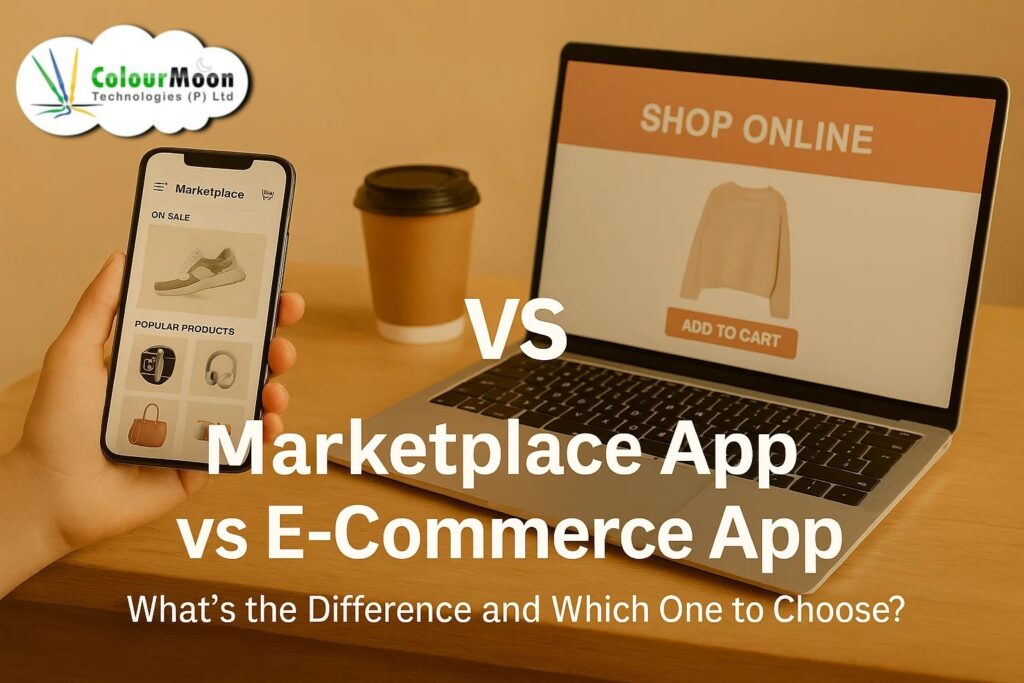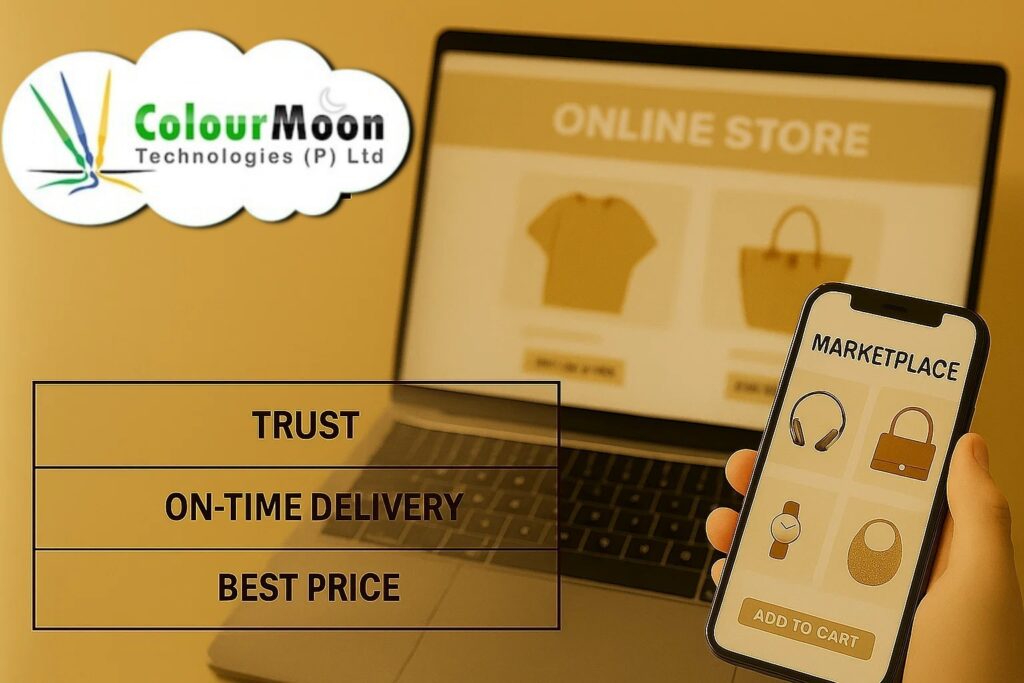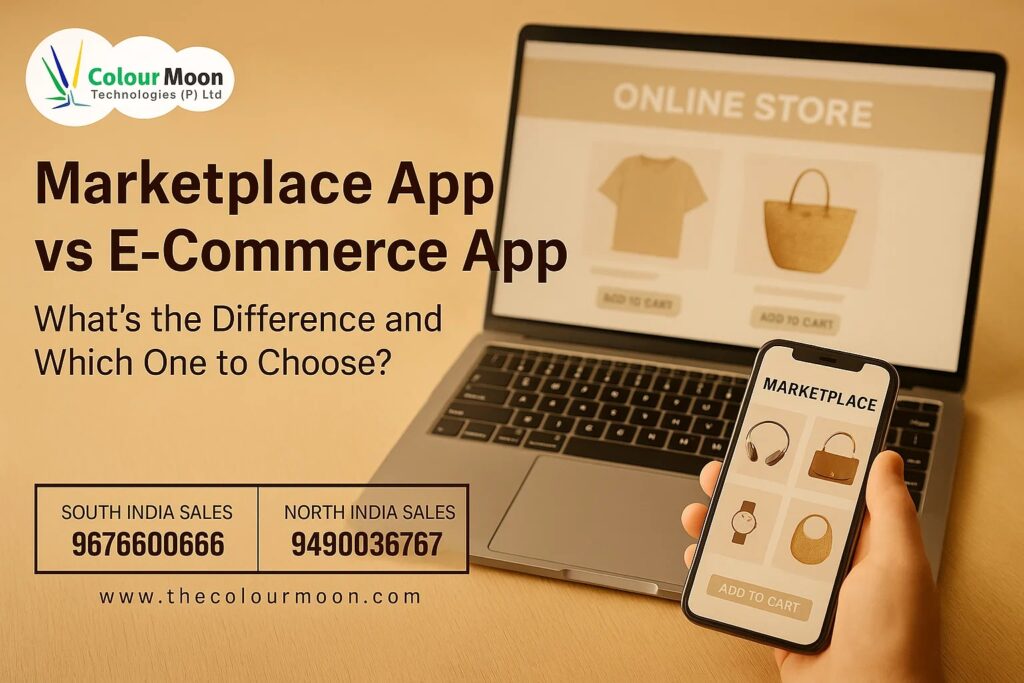What is the real difference between a marketplace app and an e-commerce app?
This question matters for startup founders and business owners who want to sell online. Many founders reach this point when they plan their first product and want a clear direction that avoids wasted cost and delays.
Here is why this comparison matters.
Data from the Reserve Bank of India shows that digital payments crossed 16,000 crore transactions in 2023, pointing to strong growth in online buying behavior (Source: RBI Annual Report 2023, Reserve Bank of India, 2023, rbi.org.in). As more people shop on mobile devices, business owners need the right app model to match their goals.
Let’s break it down.
A marketplace app connects many sellers to many buyers.
An e-commerce app supports one seller who manages products, pricing, and customer service.
Both paths can succeed. Your choice depends on control, investment, revenue goals, and expansion plans.
👉 Planning to build a Marketplace or E-commerce App? Talk to our experts at Colourmoon Technologies.
What Is a Marketplace App?

A marketplace app is a mobile platform where many sellers list products or services, and buyers choose from those listings. Buyers interact with sellers inside one shared system. Amazon, Flipkart, and Meesho follow this structure.
How does a marketplace app work?
A marketplace app connects supply and demand. Sellers upload product details. Buyers browse categories, compare prices, and place orders. The platform handles transactions, refunds, and dispute steps.
This shared structure keeps the platform neutral while allowing sellers to publish their own catalogs.
What revenue streams can a marketplace use?
Common revenue streams include:
- Commission on each sale
- Seller subscription plans
- Listing fees
- Ads for better visibility
- Delivery charges
These revenue streams appear in many market analyses. For example, a report from the United Nations Conference on Trade and Development notes that platform-style commerce relies heavily on commission structures for predictable earnings (Source: UNCTAD Digital Economy Report 2023, UNCTAD, 2023, unctad.org).
What are the advantages for business owners?
A marketplace app helps founders scale supply quickly. Sellers join with their own inventory, which reduces risk for the platform owner. More sellers bring more product variety, which attracts buyers.
What are the limitations for business owners?
A marketplace owner has less control over product quality because sellers manage their own inventory. Support issues can increase because buyers may face differences in delivery speed or product standards across sellers.
What Is an E-Commerce App?
An e-commerce app supports a single seller or a single brand. The business owner manages products, pricing, delivery, and customer service. Apps like Nykaa (single-brand mode) and BigBasket’s private-label store sections follow this format.

How does a single-store e-commerce model work?
The business sets up categories, uploads products, manages stock, and processes orders. Buyers browse the product catalog, add items to a cart, pay, and track delivery.
The seller controls every step, which helps maintain consistent product standards.
How does inventory control work in an e-commerce app?
The business keeps stock in a warehouse or retail location. This method gives control over quality checks, packaging, and delivery timing.
A report from the Ministry of Commerce and Industry in India notes that stock control methods directly affect on-time delivery rates in online retail (Source: Logistics Ease Across Different States 2023, Ministry of Commerce & Industry, India, 2023, commerce.gov.in).
Why does an e-commerce app support strong branding?
The seller creates a consistent look and tone across the catalog. Buyers see uniform product images, the same return rules, and predictable service quality.
This uniformity builds trust because the brand manages the entire shopping experience.
What are the advantages for business owners?
- Full control of the product line
- Predictable service quality
- Direct communication with customers
- Clear brand recognition
What are the limitations?
A single-store e-commerce setup requires inventory investment. The business also manages storage, packaging, and delivery. Growth depends on how fast the seller can add new products and regions.
Want a branded e-commerce app with easy product controls and secure checkout? Book a free consultation with Colourmoon Technologies. call us +91 7799900800

Marketplace App vs E-Commerce App. Complete Breakdown
This section gives a direct side-by-side comparison to help you choose the right model.
How do these two models differ in ownership, cost, and control?
The table below answers the main questions founders ask.
Comparison Table
| Factor | Marketplace App | E-Commerce App |
|---|---|---|
| Ownership | Platform owns the system. Sellers manage their own products. | One seller or brand owns and controls everything. |
| Inventory | Sellers manage their own stock. Platform has no stock risk. | Business keeps stock and manages warehousing. |
| Development Cost | Higher because the system needs seller modules, dashboards, and product onboarding features. | Lower because one seller manages everything. |
| Maintenance | More updates due to seller activity, catalog volume, and payment checks. | Simpler updates because only one catalog exists. |
| Control Over Branding | Shared branding. Seller product quality can vary. | Full control of design, tone, and buyer experience. |
| Earnings Model | Commission, ads, delivery fees, subscription plans. | Profit from product margins, delivery, and repeat customers. |
| Scalability | Scales fast when more sellers join. | Grows as the business expands inventory and delivery reach. |
Why does this comparison matter for founders?
A marketplace supports fast expansion. You can list thousands of products without owning stock.
An e-commerce app helps you build a strong brand with full control over quality.
Which Model Should You Choose? A Simple Decision Guide
How can a founder choose between a marketplace and an e-commerce app?
Your choice depends on your budget, growth plan, product control, and how much responsibility you want to take on.
Let’s break it into simple decision paths.
Decision Path 1: Do you want many sellers?
If you want multiple sellers:
Choose a marketplace app.
This model attracts more listings and grows through seller activity.
If you prefer to manage one product catalog:
Choose an e-commerce app.
You control quality and delivery.
Decision Path 2: Do you want a branded store?
If brand identity matters most:
Select an e-commerce app.
You create a consistent design, voice, and support system.
If variety matters more than brand control:
Select a marketplace app.
This structure brings wide product choice.
Decision Path 3: What is your budget?
If you have a limited budget:
Choose an e-commerce app.
It requires fewer modules and launches faster.
If you can invest in a bigger system:
Choose a marketplace app with seller dashboards and catalog uploads.
Decision Path 4: Do you want rapid growth?
If you want to scale fast:
Choose a marketplace app. Sellers bring their own stock, which expands the catalog.
If you want controlled and stable growth:
Choose an e-commerce app. You manage the product line step by step.
A short reminder
There is no wrong choice. The right model depends on your goals. This guide helps you avoid confusion and choose the path that fits your plan.
💬 Still confused? Share your idea with Colourmoon Technologies. We will help you choose the right model for your business.
Development Cost Comparison (India 2025 Estimates)
Why do app development costs vary?
Costs vary because each app type needs different modules, dashboards, and system checks. Marketplace apps need extra features for seller management. E-commerce apps need product controls and delivery features but require less complexity.
Government and industry reports show a steady rise in digital commerce investment. A report from India’s Ministry of Electronics and Information Technology confirms growth in mobile app development spending across the retail sector (Source: Digital India Annual Report 2023, MeitY, Government of India, 2023, meity.gov.in).
Let’s look at the estimated cost ranges for 2025.
Marketplace App Development Cost (India 2025)
A marketplace app needs:
- Seller onboarding tools
- Seller dashboards
- Product upload modules
- Dispute and refund flows
- Multi-seller checkout logic
Estimated cost range:
₹7,00,000 to ₹25,00,000+
Cost increases as you add advanced features like real-time inventory sync, product approval systems, and analytics.
E-Commerce App Development Cost (India 2025)
An e-commerce app needs:
- Product catalog
- Stock controls
- Cart and checkout
- Delivery flow
- Offers and coupons
Estimated cost range:
₹2,50,000 to ₹12,00,000
Cost increases when you add custom designs, multiple warehouses, or advanced delivery routing.
What factors affect pricing for both models?
1. Features
More features require more development time.
2. App design
Custom layouts take longer. Standard layouts cost less.
3. Payment systems
If the app needs multiple payment modes, the cost increases.
4. Platform choices
Android only costs less than Android + iOS.
5. Maintenance and updates
More features mean more updates across the year
Why Your App Needs the Right Tech Partner
A good development partner shapes the stability, speed, and long-term growth of your app. The structure of the code, the security of the payment system, and the reliability of server setups all depend on the partner you select.
A study by the National Institute of Standards and Technology highlights that poor software design increases failure points in digital systems across industries (Source: NIST Software Quality Report 2022, National Institute of Standards and Technology, 2022, nist.gov). This confirms that the foundation of an app matters as much as the features.
How can the right partner help you launch faster?
A strong team already has ready-to-deploy modules for login, checkout, product upload, and seller dashboards. This reduces development time and helps you enter the market without delay.
Why does UI and UX design matter?
Clear navigation keeps users from dropping out during product search or checkout.
A clean layout improves order completion rates and reduces friction.
How does a good tech partner protect your payments?
Secure payment integration prevents fraud, failed transactions, and data leaks.
The partner sets up encrypted payment gateways and safety checks that match guidelines from the Reserve Bank of India for digital payments (Source: RBI Payment Security Advisory 2023, Reserve Bank of India, 2023, rbi.org.in).
How does ongoing support help your business?
Support teams fix bugs, add features, and monitor performance. Regular updates keep your app stable as your traffic grows.
Why Colourmoon Technologies Is the Best Choice for Marketplace or E-Commerce App Development ?

Colourmoon Technologies has worked with startups and established businesses for more than 14 years. This long experience helps the team understand common app challenges and deliver stable digital products.
How many apps has the team delivered?
The team has delivered over 500 mobile applications across retail, service, education, and local business categories. This large volume of work helps the team identify patterns and build better structures for new projects.
Where does Colourmoon operate?
Colourmoon Technologies maintains strong branches in Vizag, Hyderabad, and Vijayawada. Local presence supports faster communication, clear project planning, and easy collaboration.
What type of support does the team offer?
The team offers project guidance, updates, and after-launch support.
This includes bug fixing, feature additions, and app stability checks.
How does Colourmoon assist with marketplace projects?
Colourmoon builds seller onboarding modules, dashboards, product upload tools, and secure payment flows. These features help marketplaces attract sellers and buyers quickly.
How does Colourmoon assist with e-commerce projects?
Colourmoon creates product controls, delivery flows, coupon setups, and branded UI designs. These tools help single-store owners manage stock and give buyers a smooth experience.
Start Your Marketplace or E-Commerce App With Us

Are you ready to bring your app idea to life?
Your business can enter the online market with confidence when you choose the right model and the right development team. Whether you need a marketplace with many sellers or a focused e-commerce store, our team at Colourmoon Technologies can guide you through every step.
What happens when you share your idea with us?
We listen to your plan, identify the best app structure, explain the features you need, and give a clear project timeline. This helps you move forward without confusion.
Why start now?
Mobile shopping continues to grow across India. Building your app today helps you reach buyers faster and position your business for long-term growth.
Here are your next steps:
- Speak with a Colourmoon consultant.
- Tell us your business goals.
- Choose the right model with our guidance.
- Launch your app with a stable and secure setup.
👉Planning to build a Marketplace or E-commerce App? Talk to our experts at Colourmoon Technologies.
Frequently Asked Questions (FAQ)
What is the main difference between a marketplace app and an e-commerce app?
A marketplace app connects many sellers to buyers. An e-commerce app supports one seller who manages the entire product catalog.
Which app model costs less to build?
An e-commerce app costs less because it has fewer modules. A marketplace app needs seller tools, dashboards, and approval flows, which increase the cost.
Which model grows faster?
A marketplace grows faster because new sellers bring products without the platform owner buying stock.
Which model gives full brand control?
An e-commerce app gives full control over design, product quality, service rules, and delivery.
Is a marketplace better for small budgets?
No. A small budget fits an e-commerce app better because it requires fewer features.
Can Colourmoon Technologies build both types of apps?
Yes. Colourmoon builds marketplace apps, e-commerce apps, and hybrid models with secure payment systems and clear user flows.


